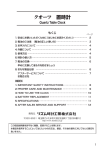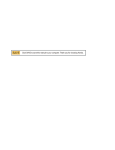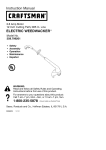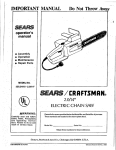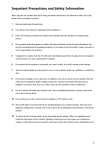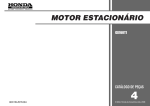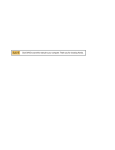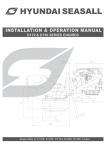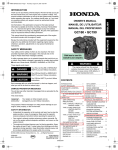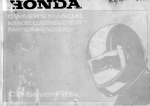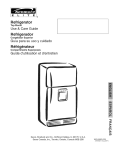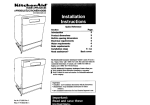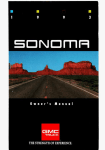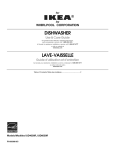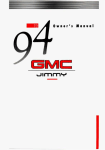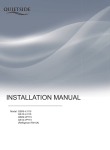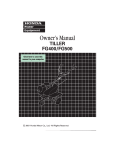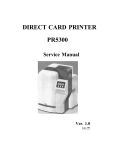Download Click SAVE to save this manual to your computer. Thank you for
Transcript
Click SAVE to save this manual to your computer. Thank you for choosing Honda. The engine exhaust from this product contains chemicals knownto the State of California to cause cancer, birth defects or other reproductive harm. Keep this owner's manual handy, so you can refer to it a t any time. This owner's manualis considered a permanent part of the engine and should remain with the engine if resold. The information and specifications included in this publication were in effect a t the timeof approval for printing. Illustrations are based on the GX160. Only the QXE2 type is equipped for both electric and manual starting.HondaMotor Co., Ltd. reservestheright,however,to discontinue or change specifications or design a t any time without notice and without incurring any obligation whatever. No part of this publication may be reproduced without written permission. Congratulations on your selection of a Honda engine. We are certain you will be pleased with your purchase of one of the finest engines on the market. We want to help you get the best results from your new engine and to operate it safely. This manual contains the information on how to do that; please read it carefully. As ou read this manual, you will find information preceded by a symbol.Thatinformationisintendedtohelpyouavoid damage to yourengine, other property, or the environment. We suggest you read thewarrantypolicytofullyunderstandits coverage and your responsibilities of ownership. The warranty policy is a separate document that should have been given to you by your dealer. When your engine needs scheduled maintenance, keep in mind that your Honda servicing dealer is specially trained in servicing Honda engines. Your Honda servicing dealer is dedicated to yoursatisfaction and will bepleased to answer your questionsand concerns. Best Wishes, Honda Motor Co., Ltd. 1 INTRODUCTION A FEW WORDS ABOUT SAFETY Your safety and the safety of others are very important. And using this engine safely is an important responsibility. To help you make informed decisions aboutsafety, we have provided operatingproceduresandotherinformationonlabelsandinthis manual. This information alerts you to potential hazards that could hurt you or others. Ofcourse, it is not practical or possible to warn you about all the hazards associatedwith operating or maintainingan engine. You must use your own good judgment. You will findimportant including: safety informationin a varietyofforms, Safety Labels - on the engine. A and one Safety Messages - preceded by a safety alert symbol of three signal words,DANGER, WARNING, or CAUTION. These signal words mean: You WILL be KILLED or SERIOUSLYHURT if you don't follow instructions. YouCANbe KILLED or SERIOUSLY HURT if you don't follow instructions. You CAN be HURT if you don't follow instructions. Safety Headings - such as IMPORTANTSAFENINFORMATION. Safety Section - such as ENGINE SAFEN. Instructions - how touse this engine correctly andsafely. This entire book is filled with important safety information read it carefully. 2 - please ENGINE SAFETY ........................................................................................ IMPORTANT SAFETY INFORMATION ................................................. 5 5 CONTROLS & FEATURES ......................................................................... COMPONENT & CONTROL LOCATIONS ............................................. CONTROLS ............................................................................................. Fuel Valve Lever ................................................................................. Engine Switch ..................................................................................... Choke Lever ...................................................................................... Throttle Lever ................................................................................... Recoil Starter Grip............................................................................ FEATURES ............................................................................................ Oil A l e e System (applicable engine types).................................. Circuit Breaker (QXE2 type only) .................................................... 7 7 8 8 9 10 11 11 12 12 12 BEFORE OPERATION .............................................................................. IS YOUR ENGINE READY TO GO? ...................................................... Check the General Condition of the Engine ................................... Check the Engine .............................................................................. Check the Equipment Poweredby This Engine ............................. 13 13 13 14 14 OPERATION ............................................................................................. SAFE OPERATING PRECAUTIONS .................................................... STARTING THE ENGINE ..................................................................... STOPPING THE ENGINE ..................................................................... SETTING ENGINE SPEED .................................................................... 15 15 15 19 20 SERVICING YOUR ENGINE ..................................................................... 21 THE IMPORTANCE OF MAINTENANCE ............................................. 21 22 MAINTENANCE SAFETY ..................................................................... MAINTENANCE SCHEDULE ............................................................... 23 REFUELING ........................................................................................... 24 FUEL RECOMMENDATIONS .............................................................. 25 ENGINE OIL LEVEL CHECK ................................................................. 26 ENGINE OIL CHANGE .......................................................................... 27 ENGINE OIL RECOMMENDATIONS ................................................... 28 TRANSMISSION OIL LEVEL CHECK(applicab1emodels) ................. 29 TRANSMISSION OIL CHANGE(1/2 reduction type) .......................... 30 AIR FILTER INSPECTION ..................................................................... 31 AIR CLEANER SERVICE ....................................................................... 32 32 Dual-Filter-Element Types ............................................................... Oil-Bath Type .................................................................................... 34 3 CONTENTS SERVICING YOUR ENGINE (continued) SEDIMENT CUP CLEANING ................................................................ SPARK PLUG SERVICE ........................................................................ IDLE SPEED ADJUSTMENT ................................................................ SPARK ARRESTER MAINTENANCE (optional part) ......................... 35 36 37 38 HELPFUL TIPS& SUGGESTIONS .......................................................... STORING YOUR ENGINE .................................................................... Storage Preparation ......................................................................... Storage Precautions ......................................................................... Removal From Storage.................................................................... TRANSPORTING .................................................................................. 39 39 39 42 43 44 TAKING CARE OF UNEXPECTED PROBLEMS ...................................... ENGINE WILL NOTSTART .................................................................. ENGINE LACKS POWER ...................................................................... FUSE REPLACEMENT(QXE2 type only)............................................ 45 45 45 46 TECHNICAL & CONSUMER INFORMATION ......................................... 47 TECHNICAL INFORMATION ................................................................ 47 Serial Number Location ................................................................... 47 Battery connections forElectric Starter (QXE2 type only)............48 Remote Control Linkage .................................................................. 49 Carburetor Modification for High Altitude..................................... 50 Oxygenated Fuels ............................................................................ 51 Emission Control System Information........................................... 52 Air Index ............................................................................................ 54 Specifications ................................................................................... 55 Wiring Diagrams .............................................................................. 57 CONSUMER INFORMATION ............................................................... 59 Honda Publications .......................................................................... 59 Warranty Service Information......................................................... 60 QUICK REFERENCE INFORMATION ............................. 4 Inside back cover IMPORTANT SAFETY INFORMATION Most accidents with engines can beprevented if youfollow all instructionsinthismanualandontheengine.Someofthemost common hazardsarediscussedbelow, along with the best way to protect yourself and others. Owner Responsibilities Honda engines are designed to give safe and dependable service if operated according to instructions. Read and understand this owner’s manual before operating the engine. Failure to do so could result in personal injury or equipment damage. Know how to stop the engine quickly, and understand the operation of all controls. Never permit anyone to operate the engine without proper instructions. Do not allow children tooperate the engine. Keep children and pets away from thearea of operation. Refuel With Care Gasolineisextremelyflammable,andgasolinevaporcanexplode. Refuel outdoors, in a well-ventilated area, with the engine stopped. Never smoke near gasoline, and keep other flames and sparks away. Always store gasoline in an approved container. If any fuel is spilled, make sure thearea is dry before starting the engine. Hot Exhaust The muffler becomes very hot during operation and remains hot for a while after stopping the engine.Be careful not to touch the muffler while it is hot. Letthe engine cool before storing it indoors. Topreventfire hazards and to provide adequateventilationfor stationary equipment applications, keep the engine at least 3 feet (1 meter)awayfrombuildingwallsandotherequipmentduring operation. Do not place flammable objects close to the engine. 5 ENGINE SAFETY Carbon Monoxide Hazard Exhaust gas contains poisonous carbon monoxide. Avoid inhalation of exhaust gas. Never run the engine ainclosed garage or confinedarea. Other Equipment Review the instructions provided with the equipment powered by this engine for any additional safety precautions that should be observed inconjunctionwithenginestartup,shutdown,oroperation,or protective apparel that maybe neededto operate the equipment. CONTROLS & FEATURES COMPONENT & CONTROL LOCATIONS MUFFLER\ THROlTLE LEVER ENGINE SWITCH (QXES type) CIRCUIT BREAKER (QXE2 type) AIR CLEANER RECOIL STARTER CHOKE LEVER FUEL VALVE LEVER ' I [Inner vent type] BREATHER TUBE STARTER GRIP FUEL TANK ELECTRIC STARTER OIL DRAIN PLUG' ' FUEL FILLER CAP 7 CONTROLS & FEATURES CONTROLS Fuel Valve Lever The fuel valve opens and closes the and the carburetor. passage between the fuel tank The fuel valve lever must in bethe ON position for the engine to run. When the engine is not in use, leave the fuel valve lever in the OFF position to prevent carburetor flooding and to reduce the possibility of fuel leakage. FUEL VALVE LEVER 8 CONTROLS & FEATURES ~~ Engine Switch The engine switchenables and disables the ignition system. The engine switch must be in the ON position for the engine to run. OFF position stops the engine. Turning the engine switch to the ALL ENGINES EXCEPT QXE2 QXE2 TYPE ENGINE SWITCH CIRCUIT BREAKER QXE2 Type The engine switch on the QXE2 type includes a START position for operating the electric starter. The key automatically returns to the ON position whenreleased from theSTART position. The circuit breaker, whichislocatedbelowthe battery charging circuit(see page 12). key, protectsthe 9 CONTROLS & FEATURES Choke Lever The choke lever opens and closes the choke valve in the carburetor. The CLOSED position enriches the fuel mixture for starting a cold engine. The OPEN position provides the correct fuel mixture for operation after starting, andfor restarting a warm engine. Someengineapplicationsuse a remotely-mountedchokecontrol rather than the engine-mounted choke lever shown here. CHOKE LEVER 1 10 CONTROLS & FEATURES Throttle Lever The throttle lever controls engine speed. Moving the throttle lever in the directions shown run faster or slower. makes the engine Someengineapplicationsuse a remotely-mountedthrottlecontrol rather than the engine-mounted throttle lever shown here. THROTTLE LEVER / Recoil Starter Grip Pulling the starter grip operates the recoil starter to crank the engin STARTER GRIP 11 CONTROLS & FEATURES FEATURES Oil Alert@ System (applicable engine types) The Oil Ale@ system is designed to prevent engine damage caused by an insufficient amount of oil in the crankcase. Before the oil level in the crankcase can fall below a safe limit, the Oil Ale@ system will automatically stop the engine (the engine switch will remain in theON position). If the engine stops andwill not restart, check the engine oil level (page 26 ) before troubleshooting in other areas. Circuit Breaker (QXEZ type only) The circuit breaker protects the battery charging circuit. A short circuit, or a battery connected with reverse polarity, will trip the circuit breaker. The green indicator inside the circuit breaker will pop out to show that the circuitbreaker has switched off.Ifthis occurs, determinethe cause of the problem, and correct it before resetting the circuit breaker. CIRCUIT BREAKER Push thecircuit reset. 12 breaker button to IS YOUR ENGINE READY TO GO? For your safety, and to maximize the service life of your equipment, it isveryimportantto take a fewmomentsbeforeyouoperatethe engine to check its condition. Be sure to take care of any problem you find, or have your servicing dealer correct it, before you operate the engine. I Improperly maintaining this engine, or failing to correct a problem before operation, could causea malfunction in which you could be seriously injured. i Always performa preoperation inspection before each operation, and correct any problem. Before beginning your preoperation checks, be sure the engine is level and the engine switch is in OFF the position. Check the General Conditionof the Engine 0 Look around and underneaththe engine for signs of oil or gasoline leaks. Remove any excessive dirt or debris, especially around the muffler and recoil starter. Look for signs of damage. Check that all shields and covers are in place, and all nuts, bolts, and screws are tightened. 13 Check the Engine Check the engine oil level (see page 26). Running the engine with a low oil levelcan cause engine damage. The Oil Alert? system (applicable engine types) will automatically stop the engine before the oil level falls below safe limits. However, toavoidtheinconvenienceofanunexpectedshutdown,always check the engine oil level before startup. Check the transmission oil level on applicable engine types (see page 29 ). Oil is essentialto transmission operation and long life. Check the air filter(see page 31 ). A dirty air filterwill restrict airflow to thecarburetor, reducing engine performance. Check the fuel level (see page 24 ). Starting with a full tank will help to eliminate or reduce operating interruptions for refueling. Check the Equipment Poweredby This Engine Review the instructions provided with the equipment poweredby this engine for any precautions and procedures that should be followed before engine startup. 14 OPERATION SAFE OPERATING PRECAUTIONS Before operating the engine for the first time, please review the IMPORTANT SAFETY INFORMATIONon page 5 and the chapter titled BEFORE OPERATION. Carbon monoxide gas is toxic. Breathing it can cause unconsciousness and even kill you. Avoid any areas or actionsthat expose you to carbon monoxide. Review the instructions provided with the equipment powered by this engineforanysafetyprecautionsthatshouldbeobserved in conjunction with engine startup, shutdown, or operation. STARTING THE ENGINE 1. Move the fuel valve lever to ON the position. FUEL VALVE LEVER 15 OPERATION 2. To start a cold engine, move thechoke lever to theCLOSED position. To restart awarm engine, leave the choke leverin theOPEN position. Some engine applications usea remotely-mounted choke control rather than the engine-mounted choke lever shown here. CHOKE LEVER I \\ 3. Move the throttlelever away from the SLOW position, about 1/3 of the way toward the FAST position. . Some engine applications use a remotely-mounted throttle control rather than the engine-mounted throttle lever shown here. T H R O l T L E LEVER 16 OPERATION 4. Turn the engine switch to ON the position. ALL ENGINES EXCEPTQXE2 QXE2 TYPE ENGINE SWITCH 5. Operate the starter. RECOIL STARTER (all engine types): Pull the starter grip lightly until you feel resistance, then pull briskly. Return the starter grip gently. STARTER GRIP 17 OPERATION ELECTRIC STARTER (QXE2 type): Turn the key to the START position, and holdit there until the enginestarts. If theenginefailstostartwithin 5 seconds, release the key, and wait at least 10 seconds before operating the starter again. piEq Usingtheelectricstarterformore than 5 seconds at a time will overheat the starter motor and can damage it. Whentheengine starts,release key, allowing it to return to the position. the ON ENGINE SWITCH (QXE2 type) 6. If the choke lever has been moved to the CLOSED position to start the engine, gradually move it to the OPEN position as the engine warms up. CHOKE LEVER 18 OPERATION STOPPING THE ENGINE To stop the engine in an emergency, simply turn the engine switch to the OFF position. Under normal conditions, use the following procedure. 1. Move the throttle lever to theSLOW position. Some engine applications use a remotely-mounted throttle control rather than the engine-mounted throttle lever shown here. THROlTLE LEVER 2. Turn the engine switch to OFF the position. ALL ENGINES EXCEPT QXEZ QXEZ TYPE ENGINE SWITCH 19 OPERATION 3. Turn the fuel valve lever to OFF the position. FUEL VALVE LEVER SETTING ENGINESPEED Position the throttle lever for the desired engine speed. Someengineapplicationsusearemotely-mountedthrottlecontrol rather than the engine-mounted throttle lever shown here. For engine speed recommendations, refer to the instructions provided with the equipment powered by this engine. THROTTLE LEVER 20 SERVICING YOUR ENGINE THE IMPORTANCE OF MAINTENANCE Good maintenance is essential for safe, economical, and trouble-free operation. It will also help reduceair pollution. Improperly maintaining thisengine, a problem or failure to correct before operation, can cause a malfunction in which you can be seriously hurt orkilled. Always follow the inspection and maintenance recommendations and schedules in thisowner's manual. To help you properlycare for yourengine, the followingpages include a maintenance schedule, routine inspection procedures, and simple maintenance procedures using basic hand tools. Other service tasks that are more difficult, or require special tools, are best handled by professionals and are normally performed by a Honda technician or other qualified mechanic. The maintenance schedule applies to normal operating conditions. If you operate your engine under unusual conditions, suchas sustained high-load or high-temperature operation, or use in unusually wet or dusty conditions, consult your servicing dealer for recommendations applicable to your individualneeds and use. Maintenance, replacement or repair of emission control devices and systems maybedoneby any engine repair establishment or individual, using parts that are "certified" to EPA standards. 21 SERVICING YOUR ENGINE MAINTENANCE SAFETY Some of the most important safety precautions follow. However, we cannotwarnyouofeveryconceivable hazard thatcan arise in performing maintenance. Only you can decide whether or not you should performa giventask. Failure to properly follow maintenance instructions and precautions cancause you to be seriously hurt orkilled. Always follow the procedures and precautions in the owner’s manual. Safety Precautions Make sure the engine is off before you begin any maintenance or repairs. This will eliminate several potential hazards: -Carbon monoxide poisoning from engine exhaust. Be sure there is adequate ventilation whenever you operate the engine. -Burns from hotparts. Let the engine and exhaust system cool before touching. -Injury from moving parts. Do not run the engine unless instructedto doso. Read the instructions before youbegin, and make sure you have the tools andskills required. Toreduce thepossibilityoffireorexplosion,becarefulwhen workingaroundgasoline. Use only anonflammablesolvent,not gasoline, to clean parts. Keep cigarettes, sparks and flames away from all fuel-related parts. Remember that your servicing dealer knows your engine best and is fully equipped to maintain and repair it. Toensurethebestqualityandreliability,useonlynew,genuine Honda parts or their equivalents for repair and replacement. 22 SERVICING YOUR ENGINE MAINTENANCE SCHEDULE Emission-related items. * Internal vent carburetor(See page7 ) with dual element type only. (Cyclone type every6 months or 150 hours.) * * Replace paper element type only. Cyclone type every 2 years or 600 hours. (1) Service more frequently when usedin dusty areas. (2) These items should be serviced by your servicing dealer, unless you have the proper tools and are mechanically proficient. Refer to Honda shop manual for service procedures. (3) For commercial use, log hours of operation to determine proper maintenance intervals. 23 SERVICING YOUR ENGINE REFUELING Fuel tank capacities GX120: 0.66 US gal (2.5 Q ,0.55 Imp gal) GX160: 0.95 US gal (3.6Q ,0.79 Imp gal) GX200: 0.95 US gal (3.6 Q , 0.79 Imp gal) With the engine stopped, remove the fuel tank cap and check the fuel level. Refill the tankif the fuel levelis low. Gasoline is highlyflammable and explosive. You can be burned or seriously injured when handling fuel. Stop the engine andkeep heat, sparks, and flame away. Handle fuel onlyoutdoors. Wipe up spills immediately. 24 SERVICING YOUR ENGINE Refuel in a well-ventilated area before starting the engine. If the engine has been running, allowit to cool. Refuel carefully to avoid spilling fuel. Do not fill above the fuel strainer shoulder. After refueling, tighten the fuel tank cap securely. Never refuel the engine inside a building where gasoline fumes may reach flames orsparks. Keep gasoline away from appliance pilot lights, barbecues, electric appliances, power tools, etc. Spilled fuel is not onlya fire hazard, it causes environmental damage. Wipe up spills immediately. m Fuel can damage paint and plastic. Be careful not to spill fuel when filling your fuel tank. Damage caused by spilled fuel is not covered under warranty. FUEL RECOMMENDATIONS Use unleaded gasoline with a pumpoctane rating of 86 or higher. These engines are certified to operate on unleaded gasoline. Unleaded gasoline produces fewer engine and spark plug deposits and extends exhaust system life. Never use stale or contaminated gasoline or an oil/gasoline mixture. Avoid getting dirt or water in the fuel tank. Occasionally youmay heara light "spark knock" or"pinging" (metallic rapping noise) while operating underheavy loads. This is no cause for concern. Ifsparkknock or pinging occurs a t asteadyengine speed, under normal load, changebrands of gasoline.Ifsparkknock or pinging persists, see an authorized Honda servicing dealer. Running the engine with persistent spark knock or pinging can cause engine damage. Running the engine with persistent spark knock or pinging is misuse, and the Distributor's Limited Warrantydoes not cover parts damaged by misuse. SERVICING YOUR ENGINE ~~~ ENGINE OIL LEVEL CHECK Check theengineoillevelwiththeenginestoppedandinalevel position. 1. Remove the filler cap/dipstick and wipe it clean. 2. Insert and remove the dipstick with out screwing it into the filler neck. Check the oil level shown on the dipstick. 3. If the oil level is low, fill to the edge of the oil filler hole with the recommended oil(see page 28). 4. Screw in the filler cap/dipstick securely. 'FILLER CAP/DIPSTICK [NOTICE I LOWER LIMIT Running the engine with a low oillevel can causeengine damage. The Oil Alert@system (applicable engine types)will automatically stop the engine before the oil level falls below safe limit. However, to avoid theinconvenienceofanunexpectedshutdown,always check the engine oil level before startup. 26 SERVICING YOUR ENGINE ENGINE OIL CHANGE Drain the used oil while the engine is warm. Warm oil drains quickly and completely. 1. Place a suitable container below the engine to catch the used oil, then remove the filler cap/dipstick and the drain plug. 2.Allow the used oil to drain completely, then reinstall the drain plug, and tightenit securely. Please dispose of used motor oil ainmanner that is compatible with the environment. We suggest youtake used oil in a sealed container to your local recycling center or service station for reclamation. Do not throwit in thetrash, pour it on the ground, or down a drain. 3. With the engine in a level position, fill to the outer edge of the oil filler holewith the recommended oil(see page28). Engine oil capacity: 0.63 US qt (0.60 0 ,0.53 Imp qt) m Running the engine with a low oillevel can causeengine damage. The Oil Alert@ system (applicable engine types) will automatically stoptheenginebeforetheoillevelfallsbelowthe safe limit. However, to avoid the inconvenience of an unexpected shutdown, fill to the upper limit, and check the oil level regularly. 4. Screw in the filler cap/dipstick securely. FILLER CAP/ f DRAIN BOLT OIL LEVEL- 27 SERVICING YOUR ENGINE ENGINE OIL RECOMMENDATIONS Oil is a major factor affecting performance and service life. Use 4-stroke automotive detergent oil. SAE IOW-30 is recommended for generaluse. Other viscosities shown in the chart may be used when the average temperature area in your is within the recommendedrange. I -30 I I I 1 I I -20 -10 0 10 20 30 I 40'C AMBIENT TEMPERATURE The SAE oil viscosity and service classification are in the API label on theoilcontainer.Hondarecommendsthatyouuse API SERVICE category SJ oil. 28 SERVICING YOUR ENGINE TRANSMISSION OIL LEVEL CHECK (applicable engine types) Check the transmission oil levelwith the engine stopped and in a level position. 1/2 Reduction Transmission With CentrifugalClutch 1. Remove the filler cap/dipstick and wipe it clean. 2. Insert and removethe dipstick without screwing it into the filler hole. Check the oil level shown on thedipstick. 3. If the oil level is low, add oil to reach the upper limit mark on the dipstick. Use the same oil that is recommended for the engine (see page 28). 4. Screw in the filler cap/dipstick securely. . . ILLER CAP/DIPSTICK UPP LlMI f 1/6 Reduction Transmission DRAIN BOLT 1. Remove the oil-level-check bolt, and see weather the oil level is edge of the bolt hole. at the 2. If the oil level is below the check bolt hole, remove the filler bolt, and add oil until1 it starts to flow out the check bolt hole. Use the same oil that is recommended for the engine (see page 28). 3. Installtheoil-level-checkboltand filler bolt. Tighten them securely. I OIL-LEVEL-CHECK BOLT 29 SERVICING YOUR ENGINE TRANSMISSION OIL CHANGE (1/2 reduction transmission with centrifugal clutch) Drain the used oil while the engine is warm. Warm oil drains quickly and completely. 1. Please a suitable container below the transmission to catch the used oil, then remove the filler capddipstick and the drain plug. 2.Allow the used oil to draincompletely, then reinstall the drain plug, and tighten it securely. Please dispose of used motor oil in a manner that is compatible with the environment. We suggestyou take Lased oil in a sealed container Do to your local recyling center or service station for reclamation. not throwit in the trash, pour it on the ground, or down a drain. 3. With the enginein a level position, fill to the upperlimit mark on the dipstick with the same oil that is recommended for the engine (see page 28). To check the oillevel, insert and move the dipstick without screwing it into the filler hole. Transmission oil capacity: 0.53 US qt (U.50 !2,0.44 Imp qt) I NOTICE I Running the engine with a low transmission oil level cancause transmission damage. 4. Screw in the filler cap/dipstick securely. FILLER CAPIDIPSTICK U LI LOWER LIMIT 30 DRAIN BOLT ’ SERVICING YOUR ENGINE AIR FILTER INSPECTION Remove the air cleaner cover and inspect the filter. Clean or replace dirtyfilterelements.Always replace damagedfilterelements.If equipped with an oil-bath air cleaner, also check the oil level. Refer to pages 32-34 for instructions that apply to the aircleaner and filter on your type engine. of PAPER FILTER ELEMENT FOAM FILTER ELEMENT STANDERD FILTER-ELEMENT DUAL-FILTERELEMENT TYPE (see p. 32-33) CYCLONE DUAL- OIL-BATH TYPE (seep. 34) TYPE (seep. 32-33) 31 SERVICING YOUR ENGINE AIR CLEANER SERVICE A dirty air filter will restrict air flow to thecarburetor, reducing engine performance. If you operate the engine in very dusty areas, clean the air filter more often than specified inMAINTENANCE the SCHEDULE. Operating the enginewithout an air filter, or with adamaged air filter, will allow dirt enter to the engine, causing rapid enginewear. This type of damage is not covered by the Distributor’s Limited Warranty. Dual-Filter-Element Types 1. Remove the wing nut from the aircleanercover,andremove the cover. STANDERD DUAL-FILTER-ELEMENT TYPE 2. Remove the wing nut from the air filter, and remove the filter. 3. Remove the foam filter from the paper filter. 4. Inspect both air filter elements, andreplace themifthey are damaged.Alwaysreplacethe paper air filter element at the scheduled interval (see page 23). 5. Clean the air filter elements if they are to bereused. 32 ELEMENT SERVICING YOUR ENGINE Paper airfilterelement:Tapthe filter element several times on a hard surface to remove dirt, or blow compressed [not exceeding air 30 psi (207 kPa, 2.1 kgf / cm’)] through the filter element from the inside. Never try to brush off dirt; brushing will force dirt into thefibers. CYCLONE DUAL-FILTER-ELEMENT TYPE SPECIAL PAN SCREW (3) PRECLEANER CAP Foam airfilterelement: Clean in warm soapy water, rinse, and allow todrythoroughly.Orcleanin A,RG nonflammable solvent and allow to dry. Dip the filter element in clean engine oil, then squeeze outall excess oil. The engine will smoke when started if too much oil is left in the foam. 6. CYCLONE TYPE ONLY: Remove the three pan-head screws from the precleaner cap, then remove the cyclone housing and air guide. Wash the parts with water, dry them thoroughly, and reassemble them. Be sure to install the air guide as shown in the illustration. Install the cyclone housingso the air intake tab fits into the groove in the precleanercap. 1 7. Wipe dirt from the inside of the air cleaner base and cover, using a moist rag. Be careful to prevent dirt from entering the air duct that leads to the carburetor. 8. Place thefoam airfilterelementoverthepaper element, and reinstalltheassembledairfilter. Be surethe gasket is in place beneath the air filter. Tighten the air filter wing nut securely. 9. Install the aircleaner cover, and tighten the cover wing nut securely. 33 SERVICING YOUR ENGINE Oil-Bath Type 1. Remove the wingnut, and remove the air cleaner cap and cover. 2. Remove the air filter from the cover, Wash the cover and filter in warm, soapy water, rinse, and allow to dry thoroughly. Or clean in nonflammable solvent and allow to dry. 3. Dip the filterin clean engine oil, then squeeze out all excess oil. The engine will smoke if too much oil is left in the foam. 4. Emptytheusedoilfromthe air cleaner case, washoutany accumulated dirt with nonflammable solvent, and dry thecase. 5. Fill the air cleaner case to theOIL LEVEL mark with the same oil that is recommended for the engine (see page28). Oil capacity: 2.0 US oz (60 cm3, 2.1 Imp 02) 6. Reassemble the aircleaner, and tighten the wing nut securely. /WING NUT OIL LEVEL 34 SERVICING YOUR ENGINE SEDIMENT CUPCLEANING 1. Move the fuel valve to the sediment cup and O-ring. OFF Dosition. then remove the fuel Gasoline is highly flammable and explosive. You can be burned or seriously injured when handling fuel. Keep heat, sparks and flame away. Handle fuel only outdoors. Wipe up spills immediately. 2. Wash the sediment cup and O-ring in nonflammable solvent, and dry them thoroughly. 3. Place the O-ring in the fuel valve, and install the sediment Tighten the sediment cup securely. cup. 4. Move the fuel valve to the ON position, and check for 1eaks.Replace the O-ring if there is any leakage. O-RING 35 SERVICING YOUR ENGINE SPARK PLUG SERVICE Recommended spark plugs: BPR6ES (NGK) W20EPR-U (DENSO) p G q An incorrect spark plug can causeengine damage. 1. Disconnect the spark plug cap, and remove any dirt from around the spark plug area. 2. Remove the spark plug with a 13/16-inch sparkplug wrench. SPARK PLUG WRENCH 3. Inspect the spark plug. Replace it the if electrodes are worn, or if the insulatoris cracked orchipped. Clean the spark plug with a wire brush if you are going toreuse it. 4. Measure the spark plug electrode gap with asuitablegauge.The g a p s h o u l d b e 0.028-0.031 i n (0.70-0.80 mm). Correct the gap, if necessary, by carefully bending the side electrode. 5. Install the spark plug carefully, by hand, to avoid cross-threading. 36 0.028-0.031 in (0.70-0.80 mm) SERVICING YOUR ENGINE 6,Afterthesparkplug seats, tightenwith wrench to compress the water. a 13/16-inchsparkplug If reinstalling the used spark plug, tighten 1/8-1/4 turn after the spark plug seat. if installing a new spark plug, tighten seats. 1/2 turn after the spark plug I NOTICE I A loose sparkplug can overheatand damage the engine. Overtightening the spark plug can damage the threads in the cylinder head. 7. Attach the spark plug cap. IDLE SPEED ADJUSTMENT 1. Start the engine outdoors, and allow temperature. it to warm up to operating 2. Move the throttle lever its to slowest position. 3. Turn the throttle stop screw to obtain the standerdspeed. idle Standerd idle speed:1,400%~rpm THROlTLE STOP SCREW / 37 SERVICING YOUR ENGINE SPARK ARRESTER SERVICE (optional equipment) Your engine is not factory-equipped with a spark arrester. In some areas, it is illegal tooperate an engine without a spark arrester. Check local laws and regulations. A spark arrester is available from authorized Honda servicing dealers. Thesparkarrester mustbe functioning as designed. servicedevery 100 hoursto keep it If the engine has been running, the mufflerwill be very hot. Allow the muffler to cool before servicing the spark arrester. 1. Remove the three 4 m m screws from the exhust deflector, and remove the deflector. 2. Removethefour 5 mm screws from the muffler protector and remove the muffler protector. 3. Remove the 4 mm screw from the spark arrester, and remove the spark arrester from the muffler. 7 - 5 mm SCREWS MUFFLER PROTECTOR EXHAUST DEFLECTOR SPARK ARRESTER 4. Usea brush to remove carbon deposits from the spark arrester screen. Be careful to avoid damaging the screen. SCREEN The spark arrester must be free of breaks and holes. Replace the spark arrester if it is damaged. 5. Install the sparkarrester, muffler protector, and exhaust deflector in the reverse order of disassembly. 38 HELPFUL TIPS& SUGGESTIONS STORING YOUR ENGINE Storage Preparation Properstoragepreparationisessential for keeping yourengine troublefree and looking good. The following steps will help to keep rustandcorrosionfromimpairingyour engine’s functionand appearance, and will make the engine easier to start when you use it again. Cleaning If the enginehas been running, allowit to cool forat least half an hour before cleaning. Clean all exterior surfaces, touch up any damaged paint, and coat otherareas that may rust with a light film of oil. Using a garden hose or pressure washing equipment can force water into the air cleaner or muffleropening. Water in the air cleaner will soak the air filter, and water that passes through the air filter or muffler can enterthe cylinder, causing damage. Water contacting a hot engine can cause damage. If the engine has been running, allow it to cool for at least half an hour before washing. Fuel Gasoline will oxidizeanddeteriorate in storage.Oldgasoline will cause hard starting, and it leaves gum depositsthatclogthefuel system. If the gasoline in your engine deteriorates during storage, you may need to have the carburetor and other fuel system components serviced or replaced. 4 The lengthoftimethatgasolinecanbeleft in yourfueltankand carburetor without causing functional problems will vary with such factors as gasoline blend, your storage temperatures, and whether the fuel tank is partially or completely filled. Theinair a partially filled fuel tankpromotesfueldeterioration.Verywarmstorage/temperatures accelerate fuel deterioration. Fuel deterioration problems may occur within a few months, or even less if the gasoline was not fresh when you filled the fuel tank. HELPFUL TIPS& SUGGESTIONS The Distributor’s Limited Warranty does notcoverfuelsystem damage or engine performance problems resulting from neglected storage preparation. a fuelstabilizerthatis Youcan extend fuel storage life by adding formulatedforthatpurpose,oryou can avoidfueldeterioration carburetor. problems and draining tank fuel by the ADDING A FUEL STABILIZERTO EXTEND FUEL STORAGE LIFE When adding a fuel stabilizer, fill the fuel tank with fresh gasoline. If onlypartiallyfilled,airinthe tank willpromotefueldeterioration during storage. If you keep a container of gasoline for refueling, be sure that it contains only fresh gasoline. 1. Add fuel stabilizer following the manufacturer’s instructions. 2. After adding a fuel stabilizer, run the engine outdoors for 10 minutes to be sure that treated gasolinehas replaced the untreated gasoline in the carburetor. 3. Stop theengine, and move the fuel valve to OFF the position. FUEL VALVE 40 , HELPFUL TIPS& SUGGESTIONS DRAINING THEFUEL TANK AND CARBURETOR 1. Place an approved gasoline container below the carburetor, and use a funnel to avoid spilling fuel. 2. Remove the carburetor drain bolt and sedimentcup, then move the fuel valve lever to the ON position. Gasoline is highly flammable and explosive. You can be burned or seriously injured when handling fuel. Keep heat, sparks and flame away. Handle fuel only outdoors. Wipe up spills immediately. SEDIMENT CUP 3. After all the fuel has drain into the container, reinstall the drain bolt and sediment cup. Tighten them securely. 41 HELPFUL TIPS& SUGGESTIONS Engine Oil 1. Change the engine oil(see page27). 2. Remove thespark plugs (see page36). 3. Pour a tablespoon(5- 10 cc) of clean engine oil into the cylinder. 4. Pull the starter rope several times to distribute the oil in the cylinder. 5. Reinstall the spark plugs. 6. Pull the starter rope slowly until1 resistance is felt and the notch on the starter pulley aligns with the hole a t the top of the recoilstarter cover. This will close the valves so moisture cannot enter the engine cylinder. Return the starter rope gently. Align notch on pulley with hole at top of cover. Storage Precautions If yourenginewillbestoredwithgasoline in thefueltankand carburetor, it is important to reduce the hazard of gasolinevapor ignition. Select a well-ventilated storagearea away from any appliance that operates with a flame, such as a furnace, water heater, or clothes dryer. Also avoid any area with a spark-producing electric motor, or where power toolsare operated. Ifpossible,avoidstorage areas withhighhumidity, promotes rust and corrosion. because that Unless all fuel has been drained from thetank, fuelleave the fuel valve lever in the OFF position toreduce the possibility of fuel leakage. 42 HELPFUL TIPS& SUGGESTIONS Position the equipment so the engine islevel. Tilting can cause fuel or oil leakage. = . With the engine and exhaust system cool, cover the engine to keep out dust. A hotengineandexhaustsystem can igniteormeltsome materials. Do not use sheet plasticas a dust cover.A nonporous cover will trap moisture around the engine, promoting rust and corrosion. If equipped with a battery for an electric starter (QXE2 type), recharge the battery once a month while the engine is in storage. This will help to extend the service life of the battery. Removal From Storage Check your engine as described in theBEFORE OPERATIONchapter of this manual. If the fuel was drained during storage preparation, fill the tank with fresh gasoline. If you keep a container of gasoline for refueling, be surethat it containsonlyfreshgasoline.Gasolineoxidizesand deteriorates over time, causing hard starting. If the cylinders were coated with oil during storage preparation, the engine may smoke briefly at startup. This is normal. 43 HELPFUL TIPS& SUGGESTIONS TRANSPORTING If the engine has been running, allow it to cool for at least 15 minutes beforeloadingtheengine-poweredequipmentonthetransport vehicle. A hot engine and exhaust systemcan burn you andcan ignite some materials. Keep the engine level when transporting to reduce the possibility of fuel leakage. Move the fuel valve lever to the OFF position. 44 ENGINE WILL NOT START 1. QXE2 electric starting: Check battery andfuse. 2. Check control positions. Possible Cause Battery discharged. Fuse burnt out. Recharge battery. Replace fuse (p. 46). Fuel valve OFF. Choke OPEN. Move leverto ON. Move lever to CLOSED unless engineis warm. Turn engine switch to ON. Refuel (p. 24). Drain fuel tank and carburetor (p. 41 1. Refuel with fresh gasoline.(p. 24) Engine switch OFF. 3. Check fuel. 4. Remove and inspect spark plugs. 5. Take engine to an authorized Honda servicing dealer, or refer to shop manual. Out of fuel. Bad fuel; engine stored without treating or draininggasoline, or refueledwith bad gasoline. Spark plugs faulty, fouled, or improperly gapped. Spark plugs wet with fuel (flooded engine). Fuel filter clogged, carburetor malfunction, ignition malfunction, valves stuck, etc. c ENGINE LACKS POWER 1. Check air filter. 2. Check fuel. authorized Honda servicing dealer, or Correction Possible Cause Filter element(s) clogged. Bad fuel; engine stored without treating or draininggasoline, or refueled with bad gasoline. Fuel filter clogged, carburetor malfunction, ignition malfunction, valves stuck, etc. Clean, gap, or replace spark plugs (p.36). Dry and reinstallspark plugs. Start engine with throttle lever in FAST position. Replace or repair faulty componentsas necessary. Correction Clean or replace filter element(s) (p. 32-34). Drain fuel tank and carburetor (p. 411. Refuel with fresh gasoline (P. 24). Replace or repair faulty componentsas necessary. TAKING CARE OF UNEXPECTED PROBLEMS FUSE REPLACEMENT (QXEZ type only) Theelectricstarterrelaycircuitandbatterychargingcircuitare protected by a 5-ampere fuse. Ifthe fuse burns out, the electric starter will not operate. The engine can be started manuallyif the fuse burns will not charge the battery. out, but running the engine 1. Remove the 6 X 12 m m screw from the rear cover of the engine switch box. 2. Remove the fusecover, and inspect the fuse. If the fuse is burnt out, remove the fuse cover, then pull out and discard the burnt-out fuse. Install a new 5-ampere fuse, and reinstall the fuse cover. Neveruse a fuse with a rating greater than 5 amperes. Serious damage to the electrical system or a fire couldresult. 3. Reinstall the rear cover. Install the 6 X 12 mm screw and tighten it securely. ENGINE SWITCH REAR COVER 6 X12mm SPECIAL SCREW J Frequent fuse failure usually indicates a short circuit or an overload in the electrical system. If the fuse burns out frequently, take the engine to a servicing Honda dealer for repair. 46 TECHNICAL & CONSUMER INFORMATION TECHNICAL INFORMATION Serial Number Location Record the engine serial number in the space below. Youwill need this serialnumberwhenordering parts, andwhenmakingtechnicalor warranty inquires (see page 60 ). Engine serial number: 47 TECHNICAL & CONSUMER INFORMATION Battery Connections for Electric Starter (QXE2 type only) Use a 12-volt batterywith an ampere-hour rating ofa t least 18 Ah. Be careful not to connect the battery in reverse polarity, as this will short circuit the battery charging system. Always connect the positive ( + ) battery cable to the battery terminal before connecting the negative ( - ) battery cable, so your tools cannotcause a short circuit if they touch a grounded part while tightening the positive ( + ) battery cable end. 1 A battery can explode if you do not follow the correct procedure, seriously injuring anyone nearby. Keep all sparks, open flames, and smoking materials away from the battery. 1. Connect thebatterypositive ( + ) cable tothe startersolenoid terminal as shown. 2. Connect the battery negative (-1 cable t o an engine mounting bolt, frame bolt, or other good engine ground connection. 3. Connect the battery positive (+) cable to the battery positive ( + ) terminal as shown. 4. Connect the battery negative ( - ) cable to the battery negative ( - ) terminal as shown. 5. Coat the terminals and cable ends with grease. NEGATIVE (- 1 BATTERY CABLE STARTER SOLENOID 'POSITIVE (+) BATTERY CABLE 48 TECHNICAL & CONSUMER INFORMATION Remote ControlLinkage Thethrottleandchokecontrollevers are providedwithholesfor optional cable attachment. The following illustrations show installation examples for a solid wire cable and for a flexible, braided wire cable. If using a flexible, braided wire cable, add a return spring as shown. It is necessary to loosen the throttle lever friction nut when operating the throttle witha remotely-mounted control. REMOTE THROTTLE LINKAGE THROTTLE LEVER PIVOT NUT RETURN SPRING Flexible wire core mouTg -4 W mounting REMOTE CHOKE LINKAGE I R ClRCLlP mm I h & mm SCREW WIRE HOLDER e LEVER THROTTLE } 1 OPTIONAL J 6 I I WIRE HOLDER CHOKE LEVER 49 TECHNICAL & CONSUMER INFORMATION Carburetor Modification for High Altitude Operation At high altitude, the standard carburetor air-fuel mixture will be too rich. Performance willdecrease, and fuel consumption willincrease. A very rich mixture will also foul the spark plug and cause hard starting. Operation at an altitude that differs from that at which this engine was certified, for extended periods of time, may increase emissions. High altitude performance can be improved by specific modifications to the carburetor. If you always operate your engine at altitudes above 6,000 feet (1,800 meters),haveyourservicingdealerperformthis carburetor modification. This engine, when operated at high altitude with the carburetor modifications for high altitudeuse, will meet each emission standard throughout its useful life. Even with carburetor modification, engine horsepower will decrease about 3.5% for each 1,000-foot (300-meter) increase in altitude. The effect ofaltitudeonhorsepower will begreaterthanthisifno carburetor modification is made. I NOTICE I When the carburetor has been modified for high altitude operation, the air-fuel mixture will be too lean for low altitude use. Operation at altitudes below 6,000 feet (1,800 meters) with a modified carburetor may cause the engine tooverheat and result in serious engine damage. Foruse atlow altitudes, have your servicing dealer return the carburetor to original factory specifications. 50 - TECHNICAL & CONSUMER INFORMATION Oxygenated Fuels Some conventional gasolines are being blended with alcohol or an ethercompound. Thesegasolinesarecollectivelyreferred t o as oxygenated fuels. To meet clean air standards, some areas of the United States and Canada use oxygenated fuelsto help reduce emissions. If you use an oxygenated fuel, be sure it is unleaded and meets the minimum octane rating requirement. Before using an oxygenated fuel, try to confirm the fuel's contents. Some states/provinces require this information to be posted on the PumpThe following are the EPA approved percentages of oxygenates: ETHANOL (ethyl or grain alcohol) 10% by volume Youmayusegasolinecontaining up t o 10% ethanol by volume.Gasolinecontainingethanol may be marketed under the name "Gasohol". MTBE (methyl tertiary butyl ether) 15% by volume You may use gasoline containing up to 15% MTBE by volume. METHANOL (methyl or wood alcohol) 5% by volume You may use gasoline containing up to 5% methanol by volume, as long as it also contains cosolvents and corrosion inhibitors to protect the fuelsystem.Gasolinecontainingmorethan 5% methanol by volumemay cause startingand/or performance problems. It may also damage metal, rubber, and plastic partsof your fuel system. If you notice any undesirable operating symptoms, try another service station, or switch to another brandgasoline. of Fuel system damage or performance problems resulting from the use ofanoxygenatedfuelcontainingmorethanthepercentagesof oxygenates mentioned aboveare not covered under warranty. TECHNICAL & CONSUMER INFORMATION Emission Control System Information Source of Emissions The combustion process produces carbon monoxide, oxides of nitrogen, and hydrocarbons. Control of hydrocarbons and oxides of nitrogenisveryimportant because, undercertainconditions,they react to form photochemical smog when subjected to sunlight. Carbon monoxide does notreact in the same way, but it is toxic. I Honda utilizes lean carburetor settings and other systems the emissions of carbon monoxide, oxides of nitrogen and hydrocarbons. to reduce The U S . and California CleanAir Acts EPA and California regulations require all manufacturers to furnish writteninstructionsdescribingtheoperationandmaintenance of emission control systems. The following instructions and procedures must be followed in order t o keep the emissions from your Honda engine within the emission standards. Tampering and Altering Tampering with or altering the emission control system may increase emissions beyond the legal limit. Among those acts that constitute tampering are: Removal or alteration of any part systems. of the intake, fuel or exhaust Alteringordefeatingthegovernorlinkageorspeed-adjusting mechanismto cause theenginetooperateoutsideitsdesign parameters. 52 TECHNICAL & CONSUMER INFORMATION Problems That May Affect Emissions If you are aware of any of the following symptoms, have your engine inspected and repaired by your servicing dealer. Hard starting or stalling after starting. Rough idle. Misfiring or backfiring under load. Afterburning (backfiring). Black exhaust smoke or high fuel consumption. Replacement Parts The emission control systems on your Honda engine were designed, built, andcertifiedtoconformwith EPA and Californiaemission regulations. We recommend the use of genuine Honda parts whenever you have maintenance done. These original-design replacementpartsaremanufactured to the samestandards as the original parts, so you can be confident of their performance. The use of replacement parts that are not of the original design and quality may impair the effectiveness of your emission control system. A manufacturer of an aftermarket partassumes the responsibility that the part will not adversely affect emission performance. The manufacturer or rebuilder of thepart must certify that use of the part will notresultin a failureoftheenginetocomply with emission regulations. Maintenance Follow the maintenance schedule on page 23. Remember that this schedule is based on the assumption that your machine will be used for its designedpurpose.Sustainedhigh-loadorhigh-temperature operation, or use in unusually wet or dusty conditions, will require more frequentservice. 53 TECHNICAL 81CONSUMER INFORMATION Air Index An Air Index Information hang tag/label is applied to engines certified to an emission durability time period in accordance with the requirements of the California Air Resources Board. The bar graph is intended to provide you, our customer, the ability to compare the emissions performance of available engines. The lower the AirIndex, the less pollution. The durability description is intended to provide you with information relating to the engine'semissiondurabilityperiod.Thedescriptive term indicates the useful-life period for the engine's emission control system. See your Emission Control Warranty foradditional information. Descriptive Term Applicable to Emissions Durability Period 50 hours (0-65 cc) Moderate 125 hours (greater than65 cc) Intermediate 125 hours (0-65 cc) 250 hours (greater than65 cc) Extended 300 hours (0-665 cc) 500 hours (greater than65 cc) it The Air Index Information hang tag must remain on the engine until is sold. Remove the hang tag before operating the engine. 54 TECHNICAL & CONSUMER INFORMATION Specifications GX 120 Length X Width X Height weight Displacement [Bore X Stroke] Max. output Max. torque Fuel consumption Ignition system PTO shaft rotation Length X Width X Height weight Engine type Displacement [Bore X Stroke] Max. output Max. torque Fuel consumption Cooling system PTO shaft rotation 11.7 X 13.4 X 12.5 in (297 X 341 X 318 mm) 28.7 Ibs (13.0 kg) Dry 4-stroke, overhead valve, single cylinder Engine type 7.3 cu-in (119 cm3) [2.4 X 1.7 in (60 X 42 mm)] 3.9 bhp (2.9 kW, 4.0 PS) at 3,600 rpm 5.4 Ibf.ft (7.4 Nsm, 0.75 kgf.m) at2,500 rpm 0.51 Ib/hph (313 g/kWh, 230 g/PSh) Forced air Cooling system Transistorized magneto Counterclockwise 12.0 X 14.3 X 13.2 in (304 X 362 X 335 mm) 33.1 Ibs (15.0 kg) Dry 4-stroke, overhead valve, single cylinder 9.9 cu-in (163 cm3) [2.7 X 1.8 in (68 X 45 mm)] 5.4 bhp (4.0 kW, 5.5 PS) a t 3,600 rpm 8.0 Ibf.ft (10.8 N.m, 1.I kgf.m) at 2,500 rpm 0.51 Ib/hph (313 g/kWh, 230 g/PSh) Forced air Transistorized magneto Ignition system Counterclockwise 55 TECHNICAL & CONSUMER INFORMATION GX200 Length X Width X Height Drv weiaht Engine type Displacement [Bore X Stroke] Max. output Max. torque Fuel consumption Coolina svstem I lanition svstem ounterclockwise rotation PTO shaft I I I 12.3 X 14.8 X 13.2in (313X 376 X 335 mm) 35.3Ibs (16.0kn) 4-stroke, overhead valve, single cylinder 12.0cu-in (196cm3) [ 2.7 X 2.1 in (68 X 54 mm)] 6.4bhp (4.8kW, 6.5PS) at 3,600rpm 9.76 Ibf.ft (13.2N.m, 1.35 kgf.m) a t 2,500 rpm 0.51 Ib/hph (313g/kWh, 230 g/PSh) Forced air Transistorized maaneto I GX120/GX160/GX200 Tuneup ITEM MAINTENANCE SPECIFICATION in Refer to page: 36 0.028-0.03 (0.70-0.80mm) IN: 0.15k0.02mm (cold) Valve clearance See your authorized EX: 0.20k0.02mm (cold) Honda dealer No other adjustmentsneeded. Other specifications Spark plug gap 56 ENGINE SWITCH I w IWHITE IIG IGREEN I -4 m 0 I CONTROL BOX FUSE 2 I 5 D r W PLUG CHARGING SPARK COIL OIL LEVEL SWITCH - Bvw BAlTERY BI BLACK LEVEL SWITCH TECHNICAL & CONSUMER INFORMATION CONSUMER INFORMATION Honda Publications - These publications will give you additional information for maintaining and repairing your engine. You may order them from your Honda engine dealer. Shop Manual This manual covers complete maintenance and overhaul procedures. It is intended tobe used bya skilled technician. Parts Catalog This manual provides complete, illustrated parts lists. 59 TECHNICAL & CONSUMER INFORMATION Warranty Service Information Servicing dealership personnel are trained professionals. They should be able to answer any question you may have.If you encounter a problem that your dealer does not solve to your satisfaction, please discuss it with the dealership’s management. The Service Manageror General Manager can help.Almost all problemsare solved in this way. If you are dissatisfiedwiththedecisionmade by the dealership’s management, contact the Honda Power Equipment Customer Relations Office. You canwrite to: American Honda MotorCo., Inc. Power Equipment Division Customer Relations Office 4900 Marconi Drive Alpharetta, Georgia 30005-8847 Or telephone: (770)497-6400 When you write or call, please give us this information: Model andserial number (see page47) Name ofdealer who sold the engine to you Name and address of dealer who services your engine Date of purchase Your name, address and telephone number A detailed description of the problem 60 QUICK REFERENCEINFORMATION Fuel TY Pe Capacity Engine Oil TY Pe Spark Plug Capacity Tvpe Carburetor Maintenance Each use First 20 hours Subsequent Unleaded gasoline with a pump octane rating of 86 or higher (page 25) GXI 20: 0.66 US gal (2.5 e , 0.55 Imp gal) GXI 60 & GX200: 0.95 US gal(3.6 e , 0.79 Imp gal) SAE IOW-30, API SJ, for general use (page 28) 0.63 US qt (0.60 0 , 0.53 Imp qt) NGK: BPRGES DENSO: W20EPR-U 0.028-0.031 in (0.70-0.80 mm) Check engine oil level. Check trakmission oillevel if applicable. Check air filter. Change engine oil. Change transmission oil if applicable. Refer to themaintenance schedule on page 23. HONIBA The Powerof Dreams 31ZH7630 00x31-ZH7-6300 Japan K1:GX120*GXI60 @ @ (HC) 32000.2001.06 in Printed

































































